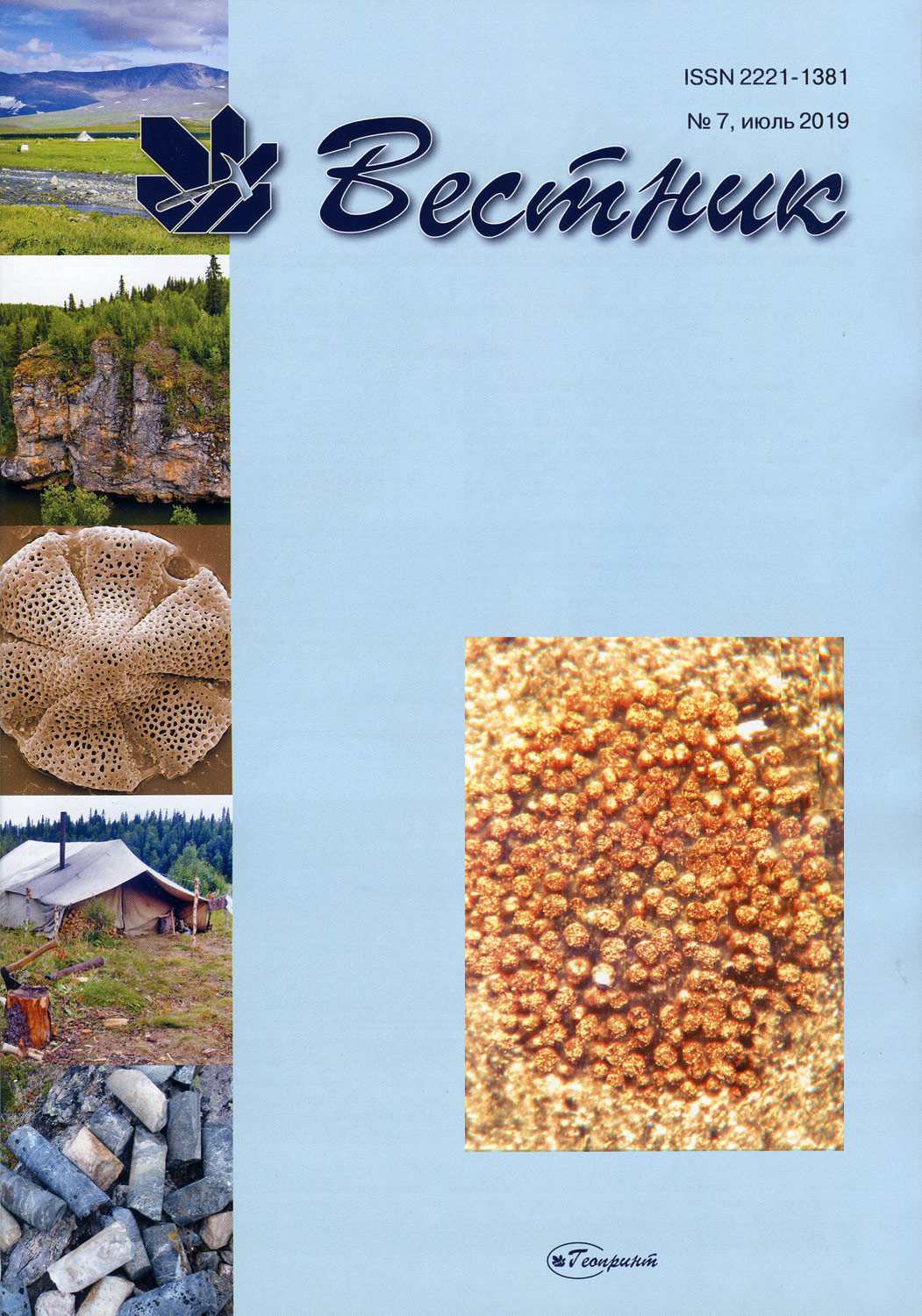pdf № 275, июль
Число скачиваний: 707

|
1 |
|
|
2 |
|
|
|
|
|
Научные статьи / Scientific articles |
|
Изотопный состав углерода нефтей нижнего палеозоя северной части Тимано-Печорского бассейна
|
3—7 |
|
DOI: 10.19110/2221-1381-2019-7-8-14 На территории Европейского Севера России по геолого-геофизическим данным выявлены две системы ортогональных разломов – субмеридионально-субширотная (С – Ю, З – В) и диагональная (СЗ – ЮВ, СВ – ЮЗ). Наиболее контрастно в геофизических полях проявляется Зимнебрежно-Красновишерская линейная зона разломов, в пределах которой нам удалось выявить узлы пересечения ортогональных глубинных разломов: Зимнебрежный, Вашкинский и Зимстанский, вероятно имеющие сходную минерагеническую специфику. На территории Тимано-Печорской плиты также выявляются Ижма-Печорский и Коротаихинский узлы пересечения ортогональных разломов, названные нами по их структурно-тектонической принадлежности. В пределах впервые выявленного Зимстанского узла пересечения ортогональных межрегиональных разломов были проведены рекогносцировочные геолого-геофизические работы, в результате проведения которых выявлен куст локальных магнитных аномалий, размер в поперечнике которого достигает 200 м. Минерагеническая специфика района Зимстанского узла нами предварительно оценивалась как производная основных (щелочно-ультраосновных?) мантийных магм. Ключевые слова: глубинное строение, тектоника, разломные зоны, аномальное магнитное и гравитационное поля. According to geological and geophysical data, two systems of faults are distinguished at the territory of European North of Russia – submeridional-sublatitudinal (N – S, W – E) and diagonal (NW – SE, NE – SW). On the northeastern of the Russian Plate, the Zimneberezhno-Krasnovishersky linear fault zone is most pronounced in geophysical fields, within which we were able to identify the intersection points of orthogonal deep faults: Zimnebrezhny, Vashkinsky and Zimstansky, which obviously have similar mineragenic specificity. At the territory of Timan-Pechora province, the Izhma-Pechora and Korotaikhinsky intersecting orthogonal faults are less clearly identified, which we named after their structural-tectonic affiliation. Reconnaissance geological and geophysical surveys were carried out within the newly allocated Zimstansky intersection site of orthogonal faults. Based on the interpretation of magnetic and gravimetric fields maps, cosmogeological maps and maps of fault tectonics, as well as the results of studies on the features of the deep structure of the consolidated crust of the Timan-Northern Urals region and adjacent territories of the Russian and West-Siberian plates in the volume of granite-gneiss and granulite of the metabasic structural-material complexes using geophysical data, we were able to identify the Zimnebrezhny, Vashkinsky and Zimstan junction points of orthogonal depths faults on the north-eastern of Russian plate, and within the Timan-Pechora – Izhma-Pechora and Korotaihinskoy. As a result of the detailed work carried out on the north-eastern outskirts of the Russian Plate (south of the Komi Republic), the location of the Zimstansky junction of deep orthogonal faults is localized and intense local gravimetric anomalies (Frolovskaya, Chetdinskaya and others) that are promising for the detection of the main bodies (alkaline - ultra basic (?)) composition in the production of detailed geological and geophysical works. Keywords: deep structure, tectonics, fault zones, anomalous of magnetic and gravitational fields, metalgenius. |
8—14 |
|
DOI: 10.19110/2221-1381-2019-7-15-24 В статье изложены результаты изучения сульфидных вкраплений в метасоматизированных габброидах массива Малютка худолазовского дифференцированного комплекса Южного Урала. Массив представляет собой небольшой шток с Cu-Ni-оруденением в приподошвенной зоне. Впервые в этом массиве выявлена платинометалльная минерализация (майчнерит, сперрилит), локализованная в скоплениях сульфидных фаз (пирротин, халькопирит, пентландит). Установлено значительное влияние гидротермально-метасоматических процессов на формирование различных типов сульфидно-платинометалльных ассоциаций, среди которых выделено 3 основных типа, соответствующих трём стадиям их образования: магматической, ранней гидротермальной и поздней гидротермальной. Показано, что гидротермально-метасоматические процессы приводили к выносу компонентов из первичных сульфидных ассоциаций с дальнейшим их переотложением как в пределах массива, так и во вмещающих породах. Наиболее активно выносились Fe и Cu, тогда как Ni и Co преимущественно концентрировались во вторичных сульфидных фазах (пирит, виоларит). Платинометалльная минерализация, выявленная в первых двух типах ассоциаций, резко различается по составу майчнерита. Майчнерит магматической стадии содержит платину (до 3.2 %) и не содержит сурьму, тогда как майчнерит ранней гидротермальной стадии отличается крайне высокой сурьмянистостью (до 9.7 %) и отсутствием платины в составе. Ключевые слова: худолазовский комплекс, массив Малютка, гидротермальные процессы, сульфидно-платинометалльные ассоциации, майчнерит. The results of study of sulfide assemblages in altered gabbro Malyutka massif of South Urals Khudolaz differentiated complex were presented in this paper. This massif is a small olivine-hornblende gabbro stock containing Cu-Ni ores located in the footwall. The platinum group minerals (PGM) — michnerite and sperrylite — were found in the pyrrhotite, chalcopyrite, and pentlandite for the first time. We determined a significant influence of hydrothermal alteration on the ore occurrence. The ore forming process was subdivided into three types of the stages or assemblages: 1) magmatic type (pyrrhotite ± pyrite–chalcopyrite–pentlandite ± violarite + magnetite assemblage containing Rh-sperrylite and Pt-michnerite); 2) early hydrothermal type (pyrite ± pyrrhotite–chalcopyrite–violarite ± pentlandite + magnetite assemblage containing high Sb-michnerite); 3) late hydrothermal type (pyrite–chalcopyrite assemblage, PGE-mineralization not determined). Hydrothermal fluids were responsible for a small Fe and Cu loss from sulfides and further redeposition of these elements. Nickel and Co contents were increased in newly formed minerals such as pyrite and violarite. The first two types of assemblages were characterize of different michnerite composition: magmatic michnerite contained Pt (up to 3.2 %) and no Sb, whereas early hydrothermal michnerite displayed extremely high-Sb contents (up to 9.7 %) and a lack of Pt. Keywords: Khudolaz complex, Malyutka massif, hydrothermal processes, sulfide-platinum metal assemblages, michnerite. |
15—24 |
Минералого-спектроскопические
|
25—32 |
Модельные эксперименты
|
33—42 |
Возраст верхней части девонской
|
43—48 |
Комментарии рецензента к статье В. С. Цыганко
|
49—50 |
|
Хроника, события, факты / Chronicle, events, facts |
|
|
Изотопная геохронология — «царица» геологических наук |
51—52 |












